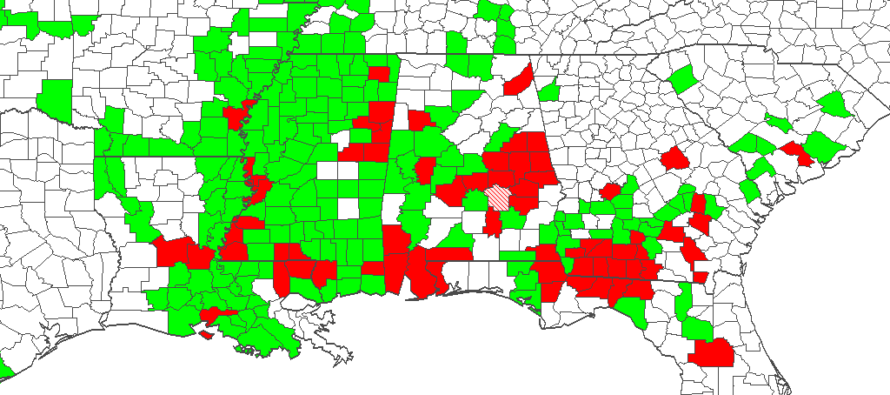Impact of Hurricane Isaac on Soybean Rust and Potential Management Decisions

Over the past six weeks soybean rust has been detected in numerous soybean fields throughout Mississippi. Even though it appears that a large number of counties have soybean plants infected with the disease, at present only low levels of soybean rust have been detected at most of the locations. At present, soybean rust can still be actively observed in 15 counties (Adams, Clay, George, Issaquena, Jefferson, Lowndes, Monroe, Noxubee, Pearl River, Pike, Prentiss, Walthall, Warren, Wilkinson, Winston). Only Winston County has an observation on kudzu every other county has been on reproductive stage (R5.2+) soybean plants in either commercial fields or sentinel plots.
Three additional counties with soybean rust were added this week (8/26, 8/27, 8/31), Monroe, Prentiss and Wilkinson counties. Soybean rust was detected in soybean sentinel plots at extremely low levels. I can’t stress enough how difficult it has been to detect soybean rust this season. To make a comparison, during 2009, at this same time, soybean rust was easy to detect. In most situations leaves were observed within 5 minutes of entering a soybean field. However, this year we have spent an exhaustive amount of time at each location simply to find a single leaf that might contain 10 sporulating pustules.
The high level of moisture that will result from Hurricane Isaac will deposit additional soybean rust spores throughout MS. Following Hurricane Isaac, additional soybean rust will be detected throughout MS over the next 14 days. But, at this stage of the season the fact that soybean rust will be observed shouldn’t be alarming.
Soybean rust biology
Plant diseases can be fickle by nature. Remember, for a disease to occur a certain set of factors need to be present at a particular location. For a specific disease to occur, the host, organism, and a conducive environment need to occur in the same space and time (note, stay tuned for future blog update on this particular topic). For soybean rust to develop, an incubation period of between 7 and 13 days subsequent to spores landing on a leaf is required. Early infection is almost impossible to detect by leaf observation. Once pustules are formed and spores are released the infection cycle repeats itself for the second generation of pustules and subsequent spore dispersal (an additional 7 to 13 days……so we’d be 14 to 26 days into the disease epidemic). Depending on the number of spores that arrived at the initial point of infection development can occur on a single leaf or more than one leaf in a field. But, as stated above, this year in particular a low level of inoculum has been observed at each location.

Soybean rust as can observed from the upper leaf surface. However, the pustules on the underside of the leaf are the most diagnostic characteristic.
Management options
The first thing that needs to be mentioned regarding this particular situation is the speed at which the soybean crop is maturing. With the cooler temperatures the soybean crop will likely continue to progress towards physiological maturity at a slower pace than was experienced several weeks ago. Keep this in mind when determining the best management decision.
Fields prior to reproductive maturity
Believe it or not there are a few fields in MS that are still in vegetative stages of maturity. At this point, those fields with vegetative stage soybean plants should not receive a fungicide. With the extremely low levels of inoculum present in the state vegetative stage soybean plants will not become infected by the fungus. Generally speaking, vegetative soybean plants are tolerant of the soybean rust fungus and require an overwhelming amount of inoculum before infection would occur.
R4 soybean fields
We realize there won’t be many of these remaining throughout the production system. This year in particular, in situations where either soybean following wheat has been planted or simply late-planted soybean considering a fungicide at approximately R4 (or some growth stage prior to R5) might be economically beneficial. Typically at this particular growth stage a stand-alone strobilurin application has been proven to be the most beneficial. However, with soybean rust having been identified throughout the state making an application with either a pre-mix (e.g. Evito-T, Quilt, Quilt Xcel, Stratego, Stratego YLD) or a tank-mix that contains a strobilurin + triazole would likely be the most beneficial.
R5 soybean fields
Fields just now reaching the R5 growth stage would likely not benefit from a fungicide application if they have not already received a fungicide. We base this particular scenario on the low level of inoculum present in MS as well as overall crop stage throughout the state.
R5+ soybean fields
Fields beyond R5, and more specifically approximately R5.5 likely do not need a fungicide application. The closer a soybean plants gets to R6 typically means that even if some leaf surface area is lost this will likely not have a negative impact on yield.




